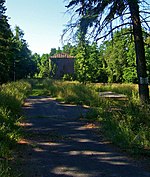High Falls Historic District

The High Falls Historic District corresponds roughly to the downtown section of the hamlet of that name in Marbletown, New York, United States. It is a 21-acre (8.5 ha) area around the intersection of state highway NY 213, Main Street, Mohonk Road (Ulster County Route 6A0 and Bruceville Road just south of Rondout Creek. Here the Delaware and Hudson Canal once crossed the creek on a large aqueduct, never rebuilt after it burned in the early 20th century. Several pieces of the canal's infrastructure, including some well-preserved locks and the canal's official National Historic Landmark plaque, are included in its 21 acres (8 ha). While the canal had the greatest effect on the small community, it has not been the only economic force acting on it over the years. It is considered a "distinctive example of mid-19th century semi-urban land use planning."
Excerpt from the Wikipedia article High Falls Historic District (License: CC BY-SA 3.0, Authors, Images).High Falls Historic District
Mohonk Road,
Geographical coordinates (GPS) Address Nearby Places Show on map
Geographical coordinates (GPS)
| Latitude | Longitude |
|---|---|
| N 41.826666666667 ° | E -74.126388888889 ° |
Address
Mohonk Road 3
12440
New York, United States
Open on Google Maps









